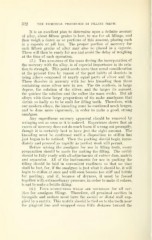Page 658 - My FlipBook
P. 658
322 THE TECHNICAL, PEOCEDUBES IN FILLING TEETH.
It is an excellent plan to determine upon a definite amount
of alloy, about fifteen grains is best, to use for all fillings, and
then weigh a dozen or so portions of this amount, placing each
in a capsule or pill box. The proper portion of mercury for
each fifteen grains of alloy may also be placed in a capsule.
These will then be ready for use and avoid the delay of weighing
at the time of each operation.
(3.) The kne.4X>ing of the mass during the incorporation of
the mercury with the alloy, is of especial importance in its rela-
tion to strength. This point needs more than usual consideration
at the present time by reason of the past habits of dentists in
using alloys composed of nearly equal parts of silver and tin.
These dissolve in mercury with far less kneading than those
containing more silver now in use. The tin controls, in large
degree, the solution of the silver, and the larger its amount,
the quicker the solution and the softer the mass works. But all
alloys with these large proportions of tin make amalgams that
shrink so badly as to be unfit for filling teeth. Therefore, with
our modern alloys, the kneading must be continued much longer,
and be done more vigorously, in order to make a good, strong
amalgam.
Any superfluous mercury apparent should be removed by
wringing out as soon as it is noticed. Experience shows that an
excess of mercury does not do much harm if wrung out promptly,
though it is certainly best to have just the right amount. The
kneading must be continued until a disposition to stiffen has
just begun to be noticed. Then the packing should begin imme-
diately and proceed as rapidly as perfect work will permit.
Before mixing the amalgam for use in filling teeth, every
preparation should be made for making the filling. The cavity
should be fully ready with all adjustments of rubber dam, matrix
and separator. All of the instruments for use in packing the
filling should be laid in convenient readiness so that no time
shall be lost, for, if the amalgam is just what it should be, it will
begin to stiffen at once and will soon become too stiff and brittle
for packing; and if, because of dryness, it must be forced
together with extraordinary pressure, in order to make it cohere,
is ajDt to make a brittle filling.
(4.) Four surroundng walls are necessary for all cav-
ities for amalgam fillings. Therefore, all proximal cavities in
bicuspids and molars must have the mesial or distal wall sup-
plied by a matrix. This matrix should be tied on to the tooth near
the gingival line and wrapped some little distance toward the


